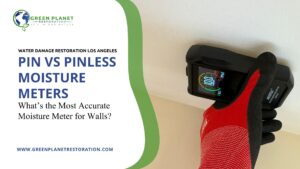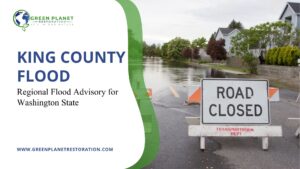A flooded basement in Seattle is far more common than most homeowners expect. Between weeks of heavy rainfall, aging infrastructure, and sloped properties that collect water, basements in neighborhoods like Ballard, Queen Anne, and Rainier Valley often end up waterlogged.
If you are staring at as little as a few inches or as much as a few feet of water in your basement, time matters. Mold can grow in as little as 24 hours, and standing water puts your foundation, wiring, and personal belongings at risk.
One of the most effective tools for tackling this emergency is a submersible pump. In this guide, we will walk you through how to safely and effectively use a submersible pump for a flooded basement in Seattle, specifically under conditions common to Seattle homes.
Did sewage or floodwater soak into your drywall? Learn Why You Must Replace Sewage-Damaged Drywall And How to Do It
Why Submersible Pumps Work Well in Flooded Basements
A submersible pump is a waterproof unit designed to function while fully underwater. It uses an internal motor to pull in water through a bottom intake and pump it out through a discharge hose to a safe drainage area – typically far from your home’s foundation.
Unlike pedestal pumps or wet vacs, submersible pumps are capable of handling deeper flooding and continuous operation, which makes them ideal for flooded basement in Seattle.
Also read: How Truck Mounted Extractors Remove Water from Carpets
Step-by-Step: How to Use a Submersible Pump in a Flooded Basement
Submersible pumps are specifically made for submerged operation and are commonly used in residential basement flooding situations. Before you begin, prioritize safety and preparation. Shut off power, place the submersible pump at the lowest point of the flood, attach a discharge hose, and pump water out to a safe drainage area. Monitor the process until all standing water is removed. Here’s exactly what to do:
- Turn off electricity to the basement: Never enter a flooded area if power is still on. Switch off the circuit breaker connected to the basement to avoid electrocution.
- Assess the Water Depth and Damage: If the water is deeper than 2 inches, a submersible pump is the right tool. Also check for signs of contaminated water, structural cracks, or damaged insulation.
- Choose the Right Submersible Pump: Use a utility submersible pump that can handle debris and continuous operation. For heavy-duty flooding, look for pumps with a high gallons-per-hour (GPH) rating.
- Place the pump in the basement: Lower the pump into the deepest section of the basement floor. Make sure it’s fully submerged to prevent dry running. Use bricks or a sandbag base to keep it stable and prevent it from tipping.
- Attach the Discharge Hose: Connect a hose to the pump outlet and lead it outdoors – preferably downhill or into a storm drain. Avoid draining water near your foundation.
- Start Pumping: Plug the pump into a GFCI-protected outlet, or use a generator if the power is out. As the pump starts working, monitor the discharge hose to check that water is flowing freely.
- Monitor Water Levels: Keep an eye on the pump and adjust the hose or reposition the pump as water levels drop. For basements with multiple low spots, you may need to move the unit.
- Shut Down and Clean the Equipment: Once water is fully drained, unplug the pump, detach the hose, and wipe the pump clean. Allow it to dry thoroughly before storing.
- Begin Drying and Cleanup: Remove wet materials, sanitize the area, and run a LGR dehumidifier for several days to prevent mold. If insulation or drywall was soaked, professional remediation may be required.
Also read: How To Handle Flood Damage in Southern California
What Are the Disadvantages of Submersible Pumps?
Most submersible pumps can operate underwater for 24-72 hours, depending on model specifications. They are designed for temporary use, not long-term submersion. While effective, submersible pumps for a flooded basement in Seattle
- Can clog if debris is present.
- Must be monitored to avoid overheating.
- Require dry storage after use to extend lifespan.
- They are heavier and harder to handle than pedestal models.
In Seattle, weather is unpredictable. From atmospheric rivers in winter to spring thaw floods, your basement needs to be ready. Keep your gutters clear and direct downspouts at least 10 feet away from your home. Test your pump every quarter, especially if your property sits on a slope or has a history of flooding.
Learn the Difference Between Flood Damage and Water Damage here: Flood Damage Cleanup vs. Sewage Damage Cleanup
Facing a Flooded Basement? Act Fast
Water damage in your basement doesn’t wait. Even after using a submersible pump, moisture trapped behind walls or under flooring can lead to long-term structural issues and mold.
If you are experiencing a flooded basement in Seattle, Washington, don’t wait to get help. Read Seattle’s water damage restoration process to learn what comes next.
Already dealing with water damage? Contact Seattle water damage restoration experts today.
Your home deserves fast, qualified attention. Let the professionals handle what the pump can’t.
____________________________
References
American Society of Home Inspectors (ASHI). (n.d.). Basement flooding: Causes and solutions. https://www.homeinspector.org
Institute of Inspection, Cleaning and Restoration Certification (IICRC). (2021). S500 water damage restoration standard (5th ed.). https://www.iicrc.org
National Fire Protection Association (NFPA). (2023). NFPA 70: National Electrical Code. https://www.nfpa.org
Pump Manufacturers Association (PMA). (2022). Submersible pump operational guidelines. https://www.pumpassociation.org
Seattle Public Utilities (SPU). (2023). Residential flood preparedness guide. https://www.seattle.gov/utilities
Structural Engineers Association of Washington (SEAW). (2021). Residential foundation water damage risks. https://www.seaw.org
___________________
Related Posts
Complete Guide to Crawl Space Maintenance and Cleanup
24 Hour Plumbing Emergency Guide
How LGR Dehumidifiers Prevent Secondary Damage
How Moisture Meters Prevent Mold Growth
Leaking Ice Makers: Why They Happen and How to Prevent Them
How To Handle Flood Damage in Southern California
Should I File an Insurance Claim for Water Damage?
8 Common Causes of Household Water Leaks and Water Damage
Psychrometry in Water Damage Restoration: How It Protects Your Home
Pin vs Pinless Moisture Meters: What’s the Most Accurate Moisture Meter for Walls?











